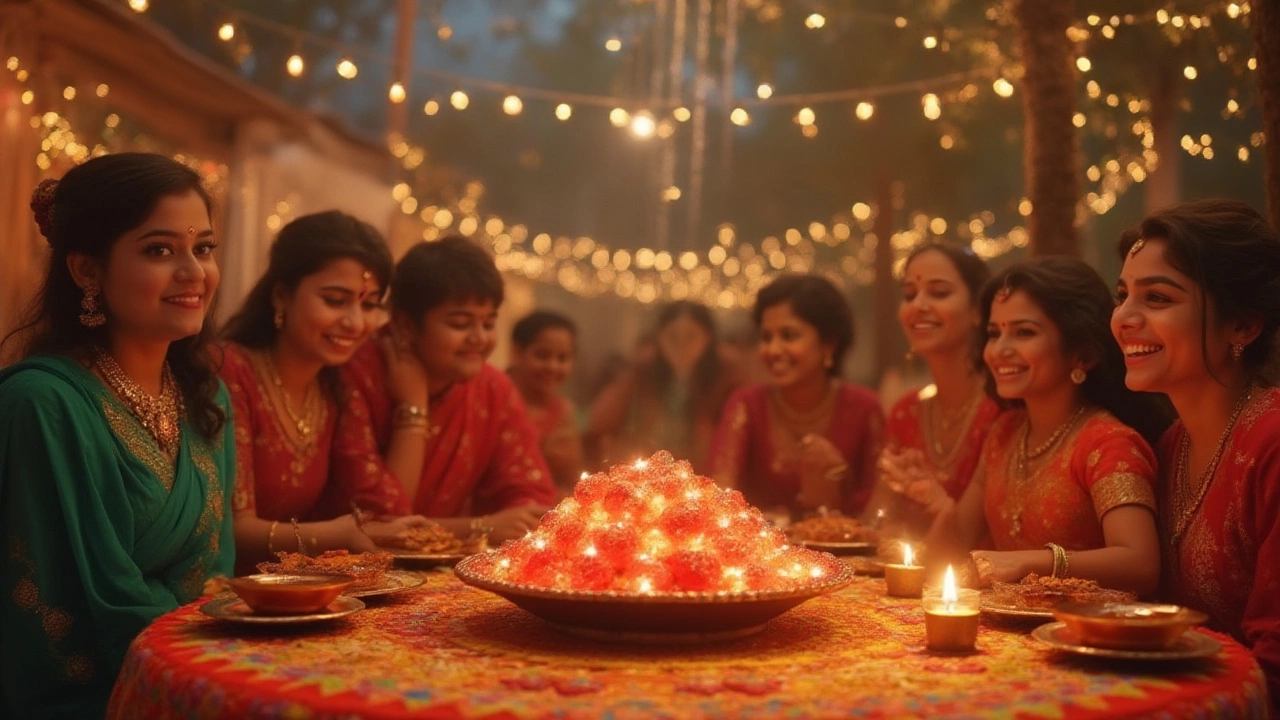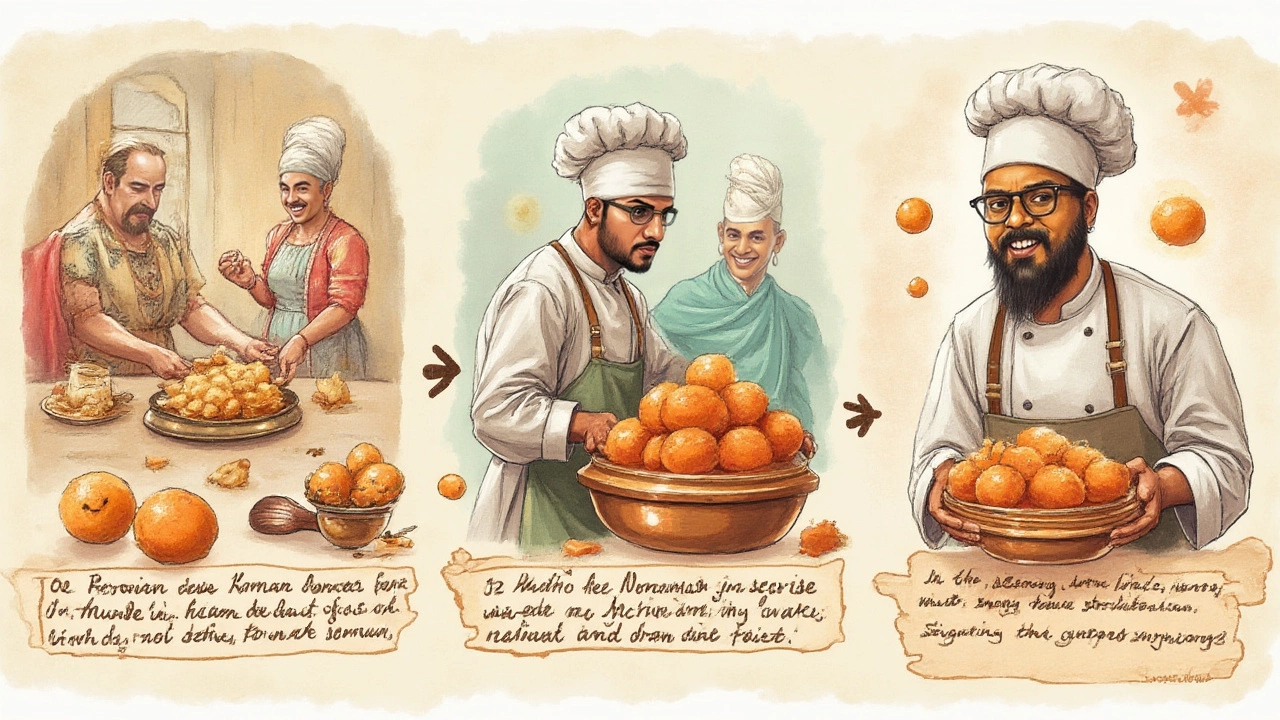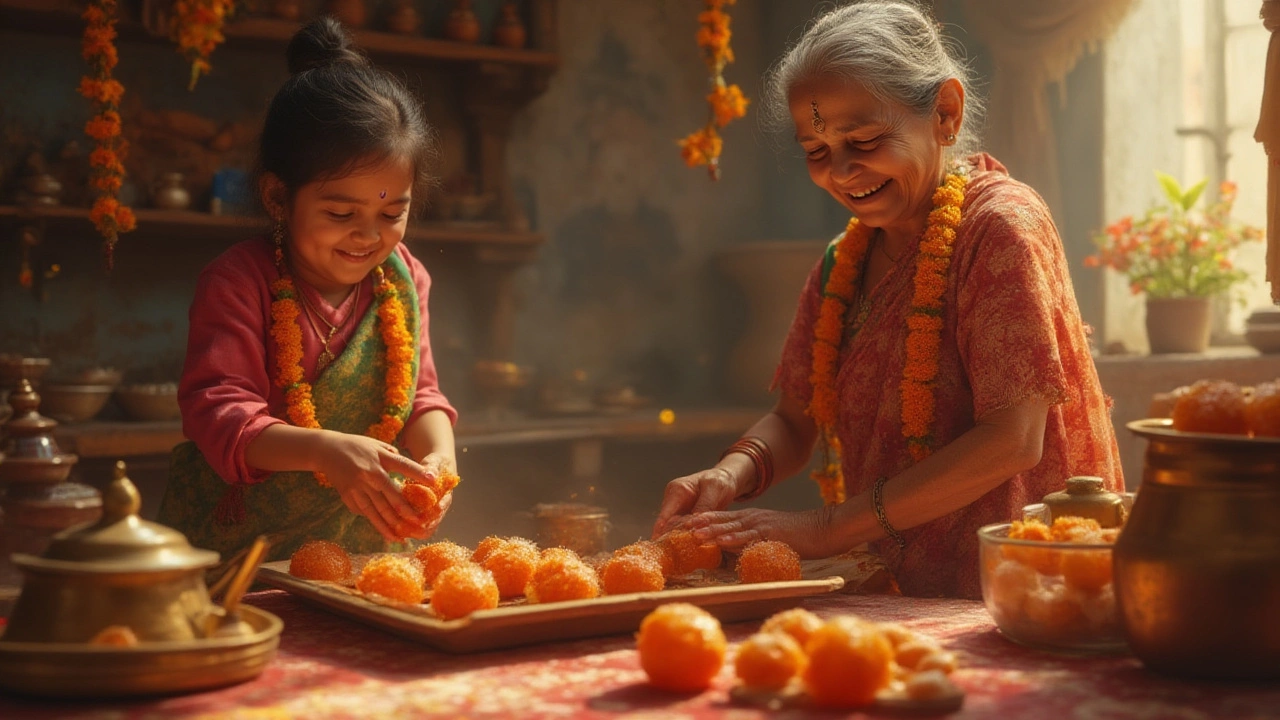11 Jul 2025
- 0 Comments
Everyone thinks of India and their mind races to spices, street food drama, and with just one sniff of cardamom and rose, pure sweet heaven. Weddings, birthdays, housewarmings, casual chai at a friend’s house—there’s always a plate of something syrupy nearby. But which sweet wins every heart, launches a thousand cravings, and elbows out the competition? The answer isn’t laddu, rasgulla, or barfi—though they put up a solid fight. Gulab jamun holds the crown as India’s most beloved sweet. Don’t believe it? Gulab jamun searches top Google. They feature at almost every Indian occasion. They even have their own quirky memes now. There’s something about those soft, syrupy spheres that turn any normal day into a celebration.
What Exactly is Gulab Jamun?
Imagine a dessert so soft it almost melts on your tongue—and then, suddenly, a burst of floral, sticky syrup fills your senses. Gulab jamun is made from khoya (reduced milk solids) mixed into a dough, shaped into balls, deep-fried until golden, then soaked in flavor-packed sugar syrup. The name says a lot: "Gulab" means rose and "jamun" is a dark fruit the sweet’s color resembles. As for its origin, historians point to medieval India where Persian influences brought floral waters and dairy-based desserts. In some old cookbooks, there’s talk about "luqmat al qadi," an Arab sweet that ancestors of modern gulab jamun used to nibble on. But India added its own flair by using local milk techniques and infusing the syrup with saffron and cardamom, giving gulab jamun the signature aroma that can make you salivate from two streets away.
The real magic is in the texture—super soft but never mushy, pillowy yet dense, never crumbly like a cake. Each ball absorbs syrup until it’s heavy with sweetness, but a truly good gulab jamun never leaks out weak, watery sugar when you bite into it. The inside should be almost fudge-like but cooked all the way through, no raw bits. Many sweet shops jealously guard their recipes, treating them like family secrets. At home, families pass down the craft, along with warnings: don’t fry on too high heat, don’t overwork the dough, use ghee for that subtle richness. You’ll spot variations everywhere—some stuff the centers with pistachios, others drop the balls into syrup still hot from the pan. Some regions coat them lightly with coconut, others color them orange with a pinch of saffron. Even in big cities, it’s still common to just eat them straight from the hand with sticky fingers, at a busy party or crowded sweet shop counter.
Why Gulab Jamun Became India’s Favorite
Here’s a crazy fact: more than four crore gulab jamuns get eaten during Diwali week each year, according to data from Indian sweets manufacturers. Gulab jamun’s true genius is being both a “fancy” sweet yet so down-to-earth—served at grand weddings and quick office parties alike. While Bengali rasgulla is a regional favorite and halwa has its diehards, gulab jamun broke language and state barriers long ago. Every region makes it its own way, but everyone knows what it’s called.
There’s another reason for its rise: convenience. Gulab jamun is easier to keep fresh for a few days compared to milk-based pedas or malai sweets that spoil quickly. Market stalls wrap them in foil trays; home cooks make them in big batches. Their syrup acts as a natural preservative, keeping them soft for repeat midnight snacking. Bollywood loves them too—watch any big movie’s wedding scene: you can bet there’s a platter of shiny gulab jamuns nearby. Celebrity chefs, including Vikas Khanna and Sanjeev Kapoor, praise gulab jamuns for the way they take on flavors—rose water, cardamom, even orange blossom sometimes.
They’re also easy to transport for gifting—no chocolate box in India matches the excitement of a mithai box with gulab jamuns peeking in. Sweets shops make sure to pack extra syrup so you get that sticky drench on opening the box at home. What about weddings? Gulab jamun has become almost a ritual—no matter how sophisticated the menu, someone insists they be there. And for birthdays? While the rest of the world is busy blowing out candles on cakes, lakhs of Indians are putting a glowing candle on a bowl of gulab jamuns instead.

Gulab Jamun Around India: Variations and Fun Facts
No two places make gulab jamun exactly the same. In the north, it’s mostly round and ultra-soft. Down south, especially in Tamil Nadu, you might find slightly firmer balls, sometimes with a pinch of semolina in the dough for texture. Kolkata shops sometimes give them a hint of molasses or add dried fruits. And if you’re near Mumbai during Eid or special festivals, ask for kala jamun—the darker, almost blackened cousin that’s fried longer and has a chewier texture.
Some families keep a tin of canned gulab jamuns on hand—yes, those exist, imported to Indian Americans in every U.S. grocery aisle. But fresh is always best. Rohit, a third-gen mithai store owner in Delhi, claims he sells over 6000 pieces on a festive day. Older uncles might tell tales about “gulab jamun eating contests” at their college festivals. One Mumbai tech company allegedly served 100,000 gulab jamuns during an anniversary event.
Then there’s innovation: bakers make gulab jamun cheesecakes, ice cream, even cupcakes for Diwali sweet tables. Michelin-starred restaurants in London and Dubai serve “deconstructed” versions. But still, the top seller is always the original soft, syrupy sphere.
Check out this quick comparison:
| Sweet | Main Ingredient | Serving Style | Occasion |
|---|---|---|---|
| Gulab Jamun | Khoya/Milk solids | Syrup-soaked balls | All festivals, weddings, birthdays |
| Rasgulla | Chenna (curdled milk) | Sugar syrup, spongy balls | Bengali festivals, pujas |
| Jalebi | Maida flour | Coiled, crispy | Breakfast, fairs |
| Laddu | Flour, ghee, sugar | Round, dry | Temple, Diwali |
Pro Tips: How to Get the Best Gulab Jamun
If you want truly mind-blowing gulab jamun, remember a few insider rules. Khoya quality is everything—never use store-bought khoya that looks dry or smells odd. Fresh, soft khoya is what gives that trademark creamy bite. Mix gently, don’t knead until tough. A pinch of baking soda lifts the dough, but too much and you’ll see bubble holes inside the balls—big mistake.
When frying, ghee is your best friend—not oil. Go slow and low. If the oil is too hot, the outside burns and the inside stays raw. Each ball should puff and turn mahogany, not black. Let them sit in warm syrup (never cold!) for at least an hour—this is where they soak up all that flavor. If you’re feeling adventurous, try flavoring the syrup—rose water is mandatory, cardamom is classic, saffron for luxury. Some advanced cooks add a drop of lemon to the syrup, which keeps it from crystallizing later.
Buying from a mithai shop? Ask for those just made, still warm: they taste wildly different from ones left in a tray all day. You can always gently rewarm at home—but never microwave, or you’ll ruin the texture.
Here are a few extra tricks:
- Add tiny pistachio or almond bits inside each ball for a tasty surprise.
- Try coconut-studded gulab jamuns if you want extra flavor and crunch.
- If making in bulk, store them in the syrup, covered, at room temperature for a day—or in the fridge for two days. Heat gently before serving.
- Want to impress guests? Serve hot gulab jamun with a scoop of good vanilla ice cream. It’s a flavor bomb no one expects, but everyone loves.
- Never freeze gulab jamuns. They lose their soft texture once thawed.

Festivals, Family, and Sentiment: The Bong of Every Celebration
No festival in India feels finished without something sweet to mark the end of a meal, and somewhere on that spread, there’s *gulab jamun* lurking, waiting to be devoured. From Holi to Eid, Raksha Bandhan to Christmas, different religions and regions all agree on one thing: it’s not a real party without a bowl of these syrupy treats. There’s a real nostalgia here—every Indian, wherever they settle in the world, remembers the taste of gulab jamun from their childhood celebrations. It isn’t just sugar and milk coming together; it’s about family laughing together, weddings packed with music and color, or fighting for the last piece while your aunt looks on in mock horror.
Kids try to grab the stickiest one on the plate at every birthday, while grandparents reminisce about the days when sweets were made from scratch over a roaring fire by patient hands. Even overseas, gulab jamun is the first treat offered at most Indian restaurants, a sign of how much it’s woven into our culture.
If you walk down the crowded aisles of a bustling sweet shop around 6 PM in any Indian city, the surest line is always at the gulab jamun counter. Even new health trends trying to cut back on sweets haven’t dimmed its popularity. Its place in India’s food history is secure, not just because it tastes amazing, but because it reminds everyone—no matter how old, no matter how far they travel—of something familiar, comforting, and forever sweet.
